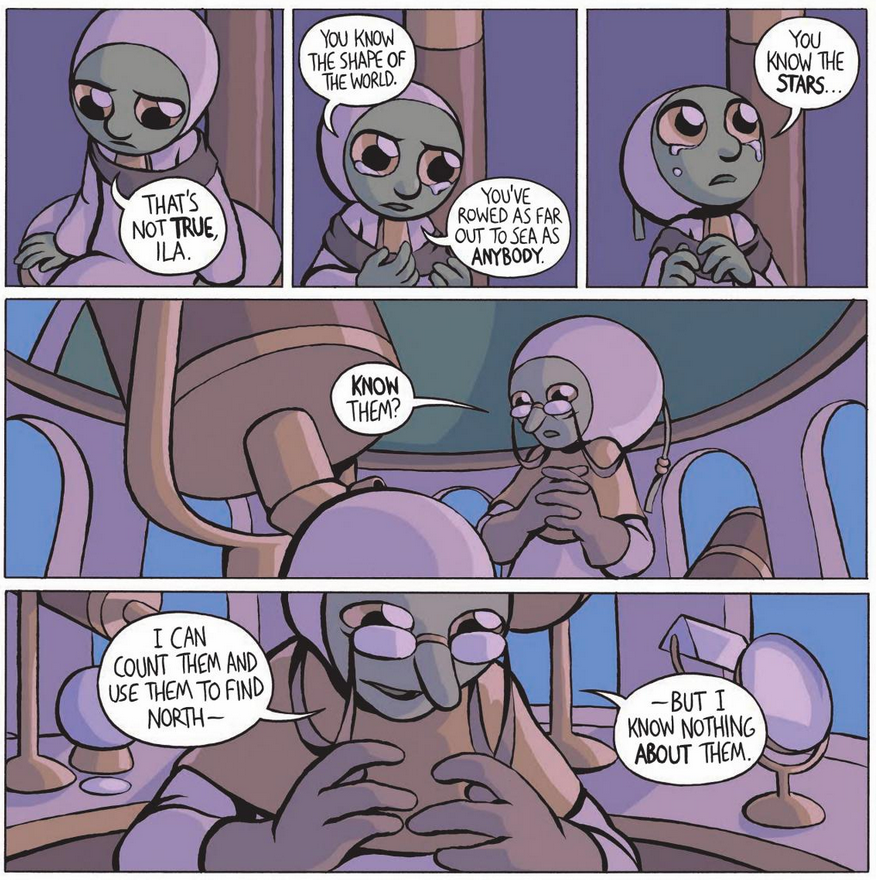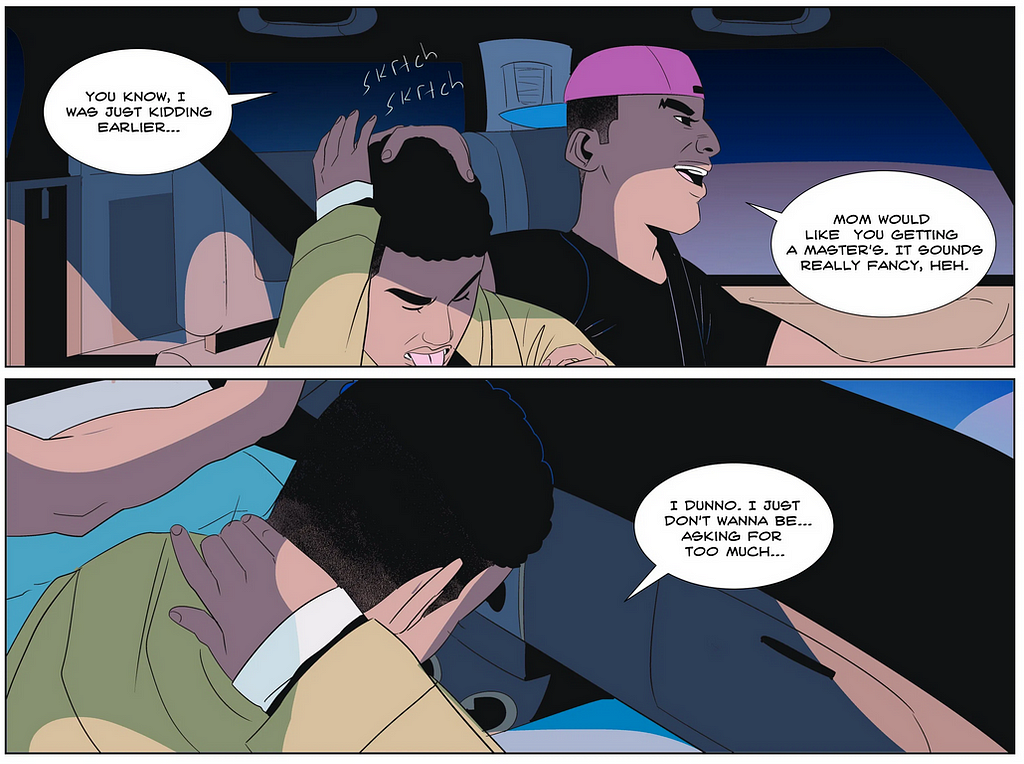
If you missed the first round of my comics roundup, find it here!
This summer — this year thus far! — has been a really interesting time in comics reading. I’ve been catching up on webcomics new and old, snapping up favorite creators’ new work, and using this Tumblr-esque reblogging turn in Instagram stories to stumble upon new artists.
Below are some works that really struck me and stuck with me these past two months:
- Evan Dahm’s Island Book (First Second, 2019)
Given the self-published and small press focus of this column, it does feel strange to be writing about Evan Dahm’s Island Book, his first book made with an actual publisher (First Second). Dahm’s long career in webcomics — mostly sprawling fabulist epics — has been a mainstay of digital comics and a starting point in webcomic-reading for many, including myself. I first became interested in Dahm during the 2006–2008 run of his minimalist/surrealist adventure story Riceboy, but his work has grown and developed since then, wrestling with the often-colonial/racist dimensions of the travel narratives that form his aesthetic genealogy (Calvino’s Invisible Cities and Melville’s Moby Dick). The result of that struggle with pleasure and history has been an exploration of imperialism in Vattu, shifting the otherwise uncompromised pleasures of worldbuilding into a more complicated aesthetic problem.

I don’t feel as much of that thrumming behind Island Book, Dahm’s newest project, despite the amount of plot it shares with Dahm’s recent Moby Dick project. Still, it builds contradictions of its own on different terms. Island Book is about encounters with monsters, communities, and landscapes that cannot be fully known or comprehended. Island Book’s heroine, Sola, has a cursed connection with a monster — or so her island village thinks — and seeks it out in a quest to find it, know it, and perhaps kill it. But the book is less a tragic allegory of obsessive striving (an impetus to conquer through understanding, exploring, or fighting) than a parable of Romantic experience. Dahm’s characteristic surrealist-fabulist orientation to worldbuilding here makes for a mysterious adventure tale where triumph or failure (to know, to conquer) are not the terms of a happy ending.
I wholly recommend this book to readers of any age — it’d make an equally good gift for a fantasy-loving kid or adult. The pacing differences between this shorter, middle-grade graphic novel and Dahm’s longer works do make the narrative structure feel more pronounced, sometimes too much so, but given the younger audience, that tight structure makes a lot of sense. The character and location designs are, as always, exactly the kind of fantasy you’ve forgotten you can have, inspiring wonder and jealousy of the arrivals that punctuate this journey.
2. Ahmara Smith’s Hellbound (self-pub, 2019)
Webcomics that have just begun can feel like a real gamble, but the joy of them really does start with their beginnings — sometimes awkward, sometimes elegant, but always exciting. And I am very excited about the talent on display in Ahmara Smith’s Hellbound, though the plot is only just thickening here in this urban fantasy about a young trans masc guy and his older brother getting sucked into a hell dimension. That premise feels young at first, like many webcomic premises do (many artists carry their stories with them from adolescence, resulting in some really fascinatingly complex execution of youthful stories!), but the narrative really relies on its characters’ acting, and the precision of their expressions and gestures on a moment-to-moment basis. There, it’s really a joy to watch Smith work; their cartooning of casual, small interactions is attentive, even expert.

You get this in full force in one of the comic’s first tender scenes: a car ride on the way to a soccer game. Mike’s older brother Sean is giving him a hard time about his secretly unfinished college degree and his hesitation in owning up to their mom that he isn’t going down the path she wants him to. The panel’s perspective here has an intimate, close-cropped view of Mike and Sean; Mike’s tongue is sticking out slightly, and Sean’s in between affectionate and focused and frustrated. This tension is undoubtedly setting up a larger family plot, but it’s also there to inform some of Mike’s unfortunately relatable timidity, which comes out in a shy panel that echoes Mike’s embarrassment by looking down at the back of his head, a hand sheepishly rubbing his neck: “I just don’t want to be asking for too much.” I like this moment for its understatedness, for the elegant and simple lines that Smith uses, which never seem to vary much in width, but which lend a smooth confidence to the entire page via these bright flat colors and sharp lines.
Early on, most webcomics were extremely idiosyncratic in visual terms (either because artists are self-trained or because it’s the one place you can do whatever you want). That’s gotten dialed down in recent years as webcomics become a portfolio item, but Hellbound sticks out to me as feeling both art-school-trained and decisive + fresh — exactly itself. The color choices are a whole lot of tangy blues and magentas, able to build a coherent overall palette across the comic-thus-far without losing specificity and surprise on each new page.
I’m excited to see where this comic will go — from the concept art, I’d say gay demon romance — especially as it ties together the hesitations of early trans life with the punchy demands of (supernatural) romance tropes. Smith’s Hellbound is a very promising beginning.
3. Anneli Sanaye Henriksson’s Venus 2 (self-pub, 2019)

Henriksson’s new zine was my introduction to her work; I picked up the tan-and-black folded screenprint at Quimby’s, one of Chicago’s beloved comic stores. Venus 2 is as much a design object as it is a comic, gridding and dividing an abstracted body into terribly abject diagrams and insects, so if you’re expecting more narrative, you’ll want to look elsewhere. But if you’re looking for a visual treatise on chronic pain, illness, and self-loathing, then Venus 2 is the zine you’re looking for.
“The linear organization of time and growth is merely an illusion,” reads one panel on the eight-panel interior of Venus 2. Indeed, the zine’s unfolding, poster-slash-comic format offers a similar thesis in its physical reading experience, undermining the “sequential” in “sequential art” by unfurling, repeating, and disassembling narrative time. This destruction/looping of time happens partly with the zine’s broken-off sentences and refrains: “THE SONG IS / I HATE MYSELF / I HATE MYSELF”; “DO YOU HATE ME? / AND WANT TO DIE / AND WANT TO DIE.” The way that you put together the text into sentences across its gridded panels will change with each read, making this whole piece an endlessly re-spinning web of segments and wholes. Spider webs and snails spiral into abstraction, bodies, letters.
I love the tactile qualities of this comic. Nasty, itchy, hairy lines dominate the visual landscape, with lettering imitating the hair of caterpillars or being segmented by contour lines like earthworms. The velvety paper it’s printed on has me rethinking my usually digital bias for comics reading, and also adds a weirdly delicate sensual facet to this claustrophobic scream of a zine.
I’ve spent more time with this zine’s five pages of images than I have with some entire books; it demands that time, earns it, and rewards a slow reader. Venus 2 is a risky, voluptuous, ugly, and excellent work.
4. Reimena Yee’s The Carpet Merchant of Konstantiniyya (self-pub, 2016/2020)
The concept of writing across culture is often given a white face, and questions of cross-cultural fiction framed from the viewpoint of whiteness: why aren’t we allowed to tell any(one’s) story? Why must people be siloed into telling stories about their own experiences and identities? I’ve held onto The Carpet Merchant of Konstantiniyya in the long exhaustion of that tiresome framing. Sure, tell cross-cultural stories — and do it well. This long-running Malaysian webcomic is becoming a trade book in 2020, and if you’d like to get your hands on a physical print of this gorgeous two-volume comic, look no further than the pre-ordering page online. Otherwise, get yourself to the Itch.io page.
The Carpet Merchant of Konstantiniyya follows a faithful, gentle man Zeynel from an anxious youth to a sweet (but not sugary) romance to a life-ending catastrophe — getting drained of his blood and turned into a vampire / djinn / ghūl. Volume One completes the love story, while Volume Two picks up seventy years later, with Zeynel’s arrival in England at the height of Orientalist fervor.

Making cross-cultural creative work is a fraught business, and Yee rises to the challenge with thorough research, thoughtful homages, and an acute sense of her indebtedness to the visual traditions she draws upon. Her skill is in simplicity as much as embellishment, using detail not so much as extraneous decoration / exotic flourish, but rather as an integral component of the comic’s narrative language. The architectural layouts and inventive uses of the gutter never feel precious or contrived.
This epic webcomic’s main narrative thread is broken up with vignettes — fables and pastiches that build an emotionally laden symbolic vocab for the main plot to draw on. In one of my favorite vignettes, a comedic puppet show plays on the identical whiteness of English people and vampires — a dissonant joke for a comic about a brown vampire living in an ecstatically parasitic imperial state. I love this webcomic for this sense of play and fun, alongside sharp emotional/political stakes. Its actual ending lands slightly flat for me, but the emotional beats before that point hit just right.
5. Garrett Young and Lane Yates’s The Garden (self-pub, 2019)
Both Garrett Young and Lane Yates work with the eerie and the bizarre, which makes this collaborative comic drawn by Young and written by Yates feel retroactively like the best, most obvious team-up. In this short, sixteen-page comic, two residents of a bucolic homestead cultivate a romantic relationship, a temporary and tentative comfort in an empty, uncanny landscape. These residents, named Neighbor and Fellow, are the only ones left in a neighborhood of mostly empty homes, save an inexplicably eyeball-covered figure who announces time’s passage and guards the hilltop border of their world.

In his other comics, Young loves a wacky, experimental layout (I recall one of his pages being broken up by a snowflake’s fractal gutter), so the gridded regularity of The Garden has an immediate, unsettling severity to it. The rigid grid may be a familiar way to design a page — just look at Watchmen — , but here in Young’s hands, it feels more menacing than conventional. This changeless place where Neighbor and Fellow live seems to require the eyeball-covered figure to say, “TIME. PASSES” for scenes to proceed, and everything about this comic coalesces around that fixed order. The calculated awkwardness of these figures, with their detailed faces and lightless eyes, recalls evangelical comics like Chick Tracts, while Yates’s formal, full-sentenced dialogue gives the characters and their timid intimacy an outsized sense of gravity, like an alternate origin story or after-story for the heterosexual couple form.
The Garden is a pretty buttoned-up, reserved kind of comic when it comes to its own strangeness; the story doesn’t give itself over to clear allegorical meaning, even though its faux-Biblical trappings seem to imply that it would. Its empty neighborhood sticks to you more for that reason; I haven’t been able to escape it fully, or the dread that accompanies its ending.
Guttermouth: Comics Roundup #2 was originally published in Anomaly on Medium, where people are continuing the conversation by highlighting and responding to this story.
